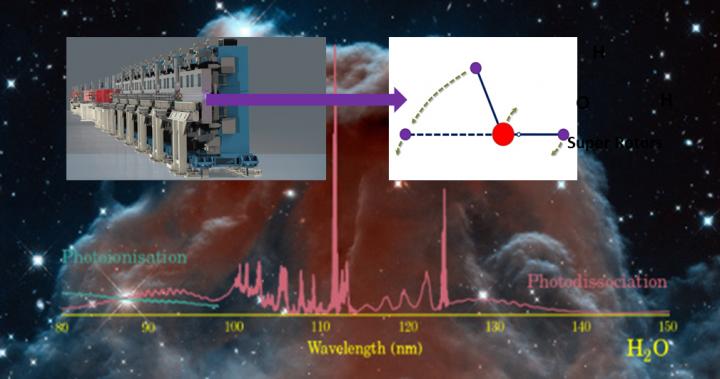Dalian Coherent Light Source reveals hydroxyl super rotors from water photochemistry

Hydroxyl super rotors produced from water photochemistry by using Dalian Coherent Light Source, the process of which is ubiquitous in the interstellar space. Credit: YUAN Kaijun
Hydroxyl (OH) is a key radical in interstellar oxygen chemistry due to its capacity to react with most gases in the interstellar medium. OH radicals with extraordinarily high rotational levels of excitation were observed by astronomers in emission from HH 211(one of the youngest known stellar outflows) and the T Tauri star DG Tau.
It is very unlikely such rotationally “hot” OH radicals would be formed from any chemical reactions, but they could originate from short wavelength photolysis of H2O. In the present work, the production mechanism of rotationally hot OH radicals was identified by systematic studies of vacuum ultraviolet (VUV) water photochemistry.
“The advent of the intense, pulsed VUV free electron laser at the DCLS opens the way for state-of-the-art molecular photodissociation dynamics studies at any user-selected VUV wavelength,” said YUAN.
“Highly rotationally excited OH radicals, so-called 'super rotors' existing above the bond dissociation energy, were observed from the photodissociation of water at 115.2 nm. Such peculiar dissociation dynamics were only observed at around 115.2 nm, which reveals interesting dissociation mechanisms,” YUAN added.
The free electron laser facility provides a chance to investigate the VUV photochemistry of small molecules. The dissociation processes of these molecules are ubiquitous in interstellar space and should be recognized in appropriate interstellar chemistry models.
###
The research work was supported by the Strategic Priority Research Program of the Chinese Academy of Sciences, the Chemical Dynamics Research Center, and the National Natural Science Foundation of China.
Media Contact
More Information:
http://dx.doi.org/10.1038/s41467-019-09176-zAll latest news from the category: Life Sciences and Chemistry
Articles and reports from the Life Sciences and chemistry area deal with applied and basic research into modern biology, chemistry and human medicine.
Valuable information can be found on a range of life sciences fields including bacteriology, biochemistry, bionics, bioinformatics, biophysics, biotechnology, genetics, geobotany, human biology, marine biology, microbiology, molecular biology, cellular biology, zoology, bioinorganic chemistry, microchemistry and environmental chemistry.
Newest articles

Superradiant atoms could push the boundaries of how precisely time can be measured
Superradiant atoms can help us measure time more precisely than ever. In a new study, researchers from the University of Copenhagen present a new method for measuring the time interval,…

Ion thermoelectric conversion devices for near room temperature
The electrode sheet of the thermoelectric device consists of ionic hydrogel, which is sandwiched between the electrodes to form, and the Prussian blue on the electrode undergoes a redox reaction…

Zap Energy achieves 37-million-degree temperatures in a compact device
New publication reports record electron temperatures for a small-scale, sheared-flow-stabilized Z-pinch fusion device. In the nine decades since humans first produced fusion reactions, only a few fusion technologies have demonstrated…





















